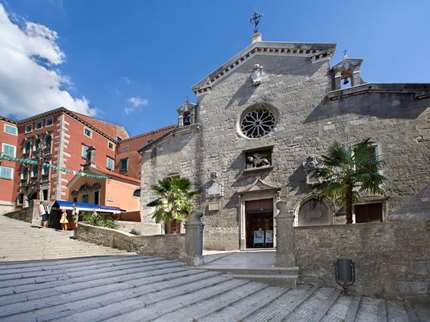Return
+385 (0)52 852477 narodni.muzej.labin@pu.t-com.hr http://www.labin.hr
The Battiala-Lazzarini Palace
The intensive red colour of its facade, lavishly decorated by architectural elements in white stone are the main characteristics of the Battiala-Lazzarini Palace, presently used by the People's Museum of the town of Labin.
Address:
Prvog svibnja 6
Find on the mapAudio guide:
The Baroque Battiala-Lazzarini Palace, located in the old town core, next to the Parish Church of the Birth of the Blessed Virgin Mary, is one of the most beautiful structures in Labin. Its impressive facade, affluently decorated windows and corners, additionally emphasized by white stone from which they were made, opposing the intensive red colour of the walls. The facade blue doors and windows add to a more dramatic overall impression of the Battiala Lazzarini Palace. The construction of one of the most beautiful buildings in Labin started in 1630 by the Battiala family. The palace was built in two phases. The older part was built in the 17th century, while the facade was started in the early 18th century and completed in 1727. The impressive structure of almost 1000 m2 in surface consists of a central body which extends in the north-south direction, and the elongated rectangular wing of the east-west direction. The first palace owners, the Battialas, were of the Turkish-Albanian descent. They had several estates in Istria, but chose Labin as their residence, in the current Battiala Lazzarini palace. In the 19th century, a member of the Battiala family, Margherita, married to Lodovico Lazzarinija, marking the beginning of the Labin branch of the Battiala Lazzarini family. Their family crest had a symbol of mortality, the phoenix, and bore the motto 'Moriendo renascitur'. The last palace owners were the three brothers, Giuseppe, Nicolò and Tommaso. After the WW2, the palace was nationalized as a boarding school at first and then turned into apartments. From 1960, it has been the site of the People's Museum of the town of Labin. The building was thoroughly renovated and restored from 1982 until 1994.







